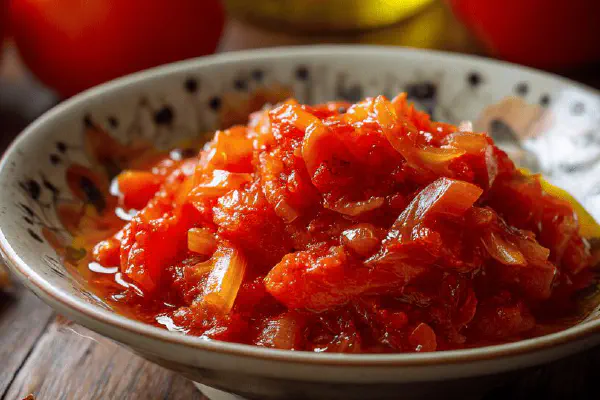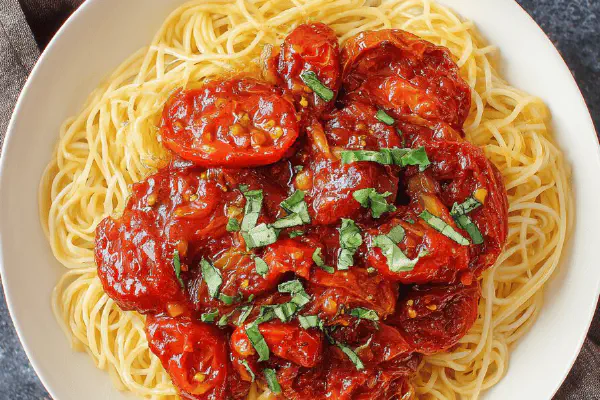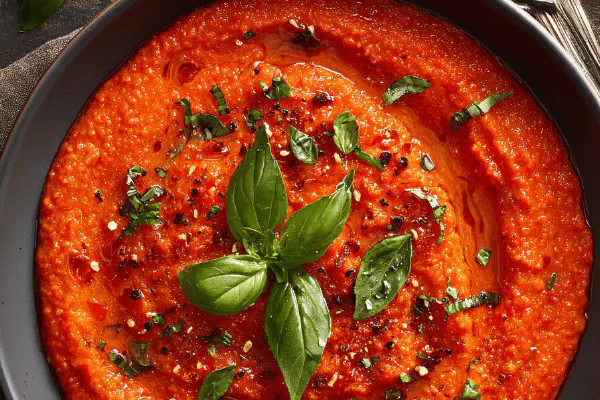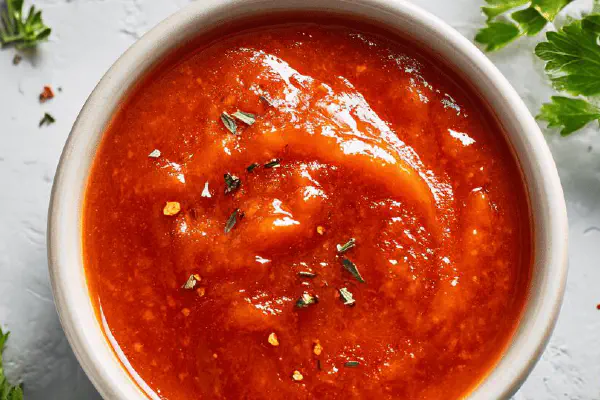Fresh Tomato Sauce Twist

By Emma
Certified Culinary Professional
Ingredients
- 2 1/2 kilograms fresh plum tomatoes (approx 25 tomatoes)
- 4 garlic cloves peeled
- 1 medium shallot peeled and chopped
- 80 ml extra virgin olive oil
- 1 teaspoon salt
- 1/2 teaspoon black pepper
- 1 teaspoon dried oregano (optional)
About the ingredients
Method
- Score firm tomatoes with a small cross at the base. Boil a large pot of water. Immerse tomatoes for 25 seconds; watch closely so they don’t cook through.
- Immediately transfer to a big bowl of ice water to halt cooking. This shocks skins to loosen; peel carefully starting at the scored cross. Then halve and squeeze out seeds gently. Retain juice—don’t discard, add it back later.
- Roughly chop peeled tomatoes. In a bowl, combine with crushed garlic and shallot pieces. Don’t puree too much; leave chunky bits to retain fresh texture.
- Heat olive oil in a heavy-bottomed pan over medium heat until slightly shimmering but not smoking. Toss in garlic and shallot to soften, stirring often. Aromas should bloom but do not brown them or bitterness creeps in.
- Add tomato mixture, including juices. Stir to coat in oil, raise heat to bring to a soft simmer. Bubbles should form steadily, not furiously.
- Lower heat to keep gentle simmer. Cook uncovered, stirring now and then so sauce thickens evenly without catching on bottom. Expect 45 to 55 minutes. You want sauce reduced by about a third or until reaching spoon-coating consistency—thick but still a bit loose.
- Season with salt, pepper and oregano if using. Taste often. Too tart? A pinch of sugar helps balance acidity but add little by little.
- Final step: test by dragging spoon across surface; sauce should hold shape briefly before filling back in.
- If sauce becomes too thick, a splash of reserved tomato juice or water adjusts consistency instantly. If thin, simmer a little longer; patience rewards with deeper flavor.
- Serve hot on pasta, toasted bread, or as base for other dishes.
Cooking tips
Chef's notes
- 💡 Score tomatoes shallow, no deep cuts—peels slip off quick. Boil water rolling, plunge for max 25 seconds only; too long cooks insides. Shock in ice water fast or skins cling, peeling becomes torture. Juice keep, don’t pour out; body of sauce relies on it. Seeds squeezed out mostly, some left adds rustic texture if you prefer. Chunky tomatoes not mush, fresh feel.
- 💡 Olive oil heat just till shimmer shows, no smoke. Toss garlic, shallot gently to soften, smell blossoms but no browning—watch stove and pan edge for color shift. Bitterness creeps fast if browned. Stir often, low-medium heat steady. Garlic and shallot soften creates aroma base, sweeter, less harsh than garlic solo.
- 💡 Simmer tomatoes at gentle bubble, not rolling boil. Look for bubbles slowing, colors deepen to a rich red—signaling reduction. Stir occasionally, scrape bottom or frying pan scorch spots form. Thickens slowly; aim for coat back of spoon, sauce clings but flows. If thick too fast, a splash reserved tomato juice or water thins instantly, avoid scorch or burn.
- 💡 Salt late in cooking; early salt draws water from tomatoes, thinning sauce. Add pinch, taste, adjust carefully after about 40 minutes reduction, flavors concentrate. Oregano optional, best added with salt or last minutes. Fresh herbs break down to mush here, dried adds subtle earth.
- 💡 If no shallots, substitute with finely minced leeks or mild onion but chop very small to avoid big chunks. Taste shifts slightly; keep that base mellow. Tomato choice matters—plum or Roma preferred, less watery, meaning thicker sauce. Watery tomatoes need longer simmer or risk thin sauce texture.
Common questions
Why peel tomatoes before cooking?
Peeling stops bitter skins in sauce. Easier to chop too. Skin tough, sticks in mouth. Use quick blanch-ice bath to loosen skins fast. Without peeling sauce can be gritty or bitter sometimes.
What if sauce burns or sticks?
Stir more often, lower heat. Add reserved tomato juice or splash water if surface thickens too fast. Use heavy pan bottom to disperse heat. Burned taste ruins everything. Keep watch on pan edges for dark bits.
Can I swap ingredients?
Yes, swap shallots with leeks or mild onion, chopped fine to avoid big bites. Oregano optional, add dried for earthiness late or skip if you want cleaner tomato flavor. Garlic mandatory for base aroma tastes better with shallots together.
How to store leftovers?
Cool fully before refrigerating in airtight container. Lasts 3 days usually. Freeze in portions for months; good reheated slow in pan, add splash water if thickened too much. Don’t keep warm on stove too long or flavor dulls.



